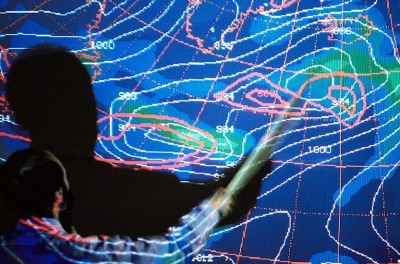An artificial intelligence (AI) model developed by Microsoft can accurately forecast weather and air pollution for the whole world — and it does it in less than a minute.
The model, called Aurora, is one of a slew of AI weather-forecasting tools being developed by tech giants, including GraphCast from Google DeepMind in London and FourCastNet from Nvidia, based in Santa Clara, California. But Aurora’s ability to quickly predict air pollution globally is pioneering, say researchers.

DeepMind AI accurately forecasts weather — on a desktop computer
“This, for me, is the first big step in a journey of atmospheric chemistry and machine learning,” says machine-learning researcher Matthew Chantry at the European Centre for Medium-Range Weather Forecasts (ECMWF) in Reading, UK.
Conventional weather forecasting uses mathematical models of physical processes in the atmosphere, land and sea. To predict air-pollution levels, researchers have previously used machine learning along with conventional mathematical models, says Chantry. Aurora seems to be the first entirely AI model to generate a global pollution forecast — which is a much more complex task than weather forecasting, says Chantry.
“That was the thing where I went: wow, that’s a really cool result,” he says. The benefit of AI models is that they often require less computational power to make predictions than do conventional models, says Chantry.
AI researcher Paris Perdikaris at Microsoft Research AI for Science in Amsterdam and his colleagues found that Aurora could in less than a minute predict the levels of six major air pollutants worldwide: carbon monoxide, nitrogen oxide, nitrogen dioxide, sulfur dioxide, ozone and particulate matter. Its predictions span five days. It can do it “at orders of magnitude smaller computational cost” than a conventional model used by the Copernicus Atmosphere Monitoring Service at the ECMWF, which predicts global air-pollution levels, the team wrote in a preprint1 published on arXiv on 20 May.

How AI is improving climate forecasts
Aurora’s predictions were of a similar quality to those of the conventional model. Policymakers use such predictions to track air pollution and protect against the related health harms. Air pollution has been linked to an increased risk of asthma, heart disease and dementia.
The researchers trained Aurora on more than a million hours of data from six weather and climate models. After training the model, the team tweaked it to predict pollution and weather globally. The model generates a ten-day global weather forecast alongside the air-pollution prediction.
The team says that, on some tasks, Aurora could outperform other AI weather-forecasting models, such as GraphCast — which can outperform conventional models and make global weather predictions in minutes. But it is too early to make a definitive comparison, says Chantry. “You’d have to spend a lot of time, and probably have access to the models themselves, to be able to really go into detail and say with some certainty that model A is better than model B,” he says.
Further research will reveal whether ‘foundational’ AI models trained on diverse data sets, such as Aurora, perform better than those trained on a single data set, such as GraphCast. “There’s lots of cool science to be done,” he says.
